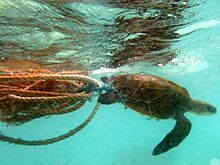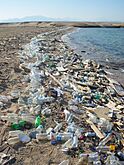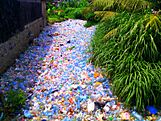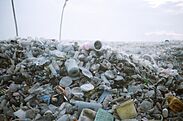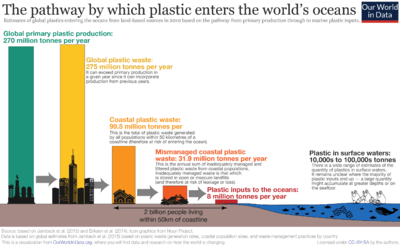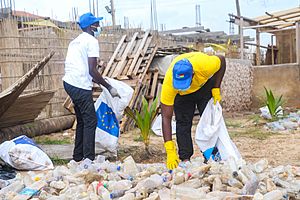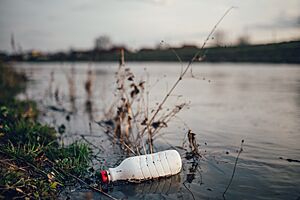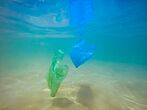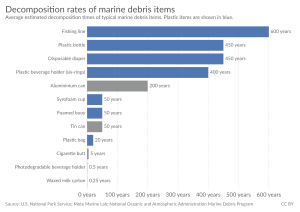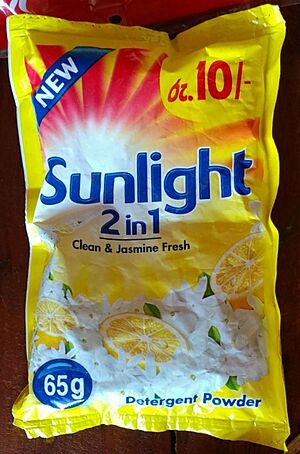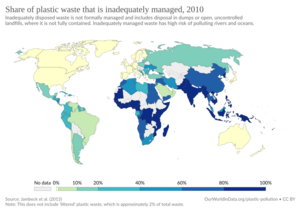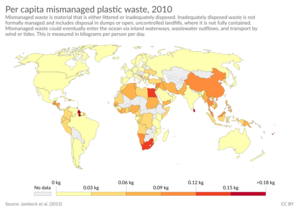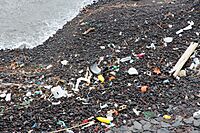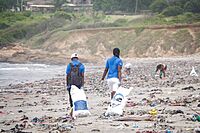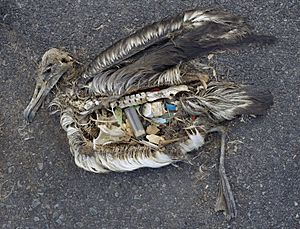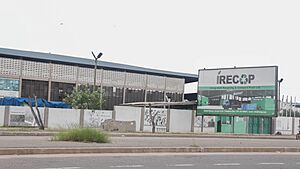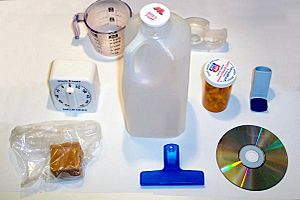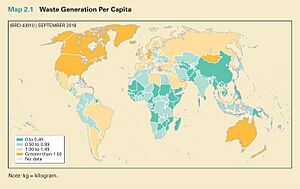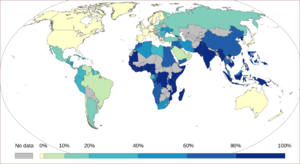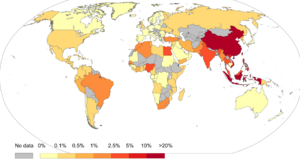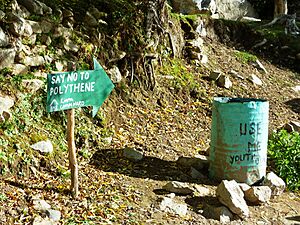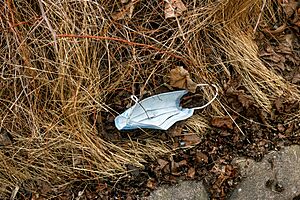Plastic pollution facts for kids
- Olive ridley sea turtle entangled in a ghost net in the Maldives
- Plastic pollution of Sharm el-Naga beach, near Safaga, Egypt
- Piles of plastic waste on the government-authorized "garbage island" of Thilafushi, Maldives
- A tributary of the Wouri River in Douala, Cameroon, completely clogged with plastic.
Plastic pollution happens when plastic items and tiny plastic pieces build up in Earth's environment. This causes harm to people, animals, and their homes. Plastics that cause pollution are grouped by their size: micro (very small), meso (medium), or macro (large).
Plastics are cheap and strong, making them useful for many things. Because of this, companies often choose plastic over other materials. However, most plastics are hard for nature to break down. This means they stay in the environment for a very long time. These two reasons together mean a lot of plastic waste ends up in nature. It stays in our ecosystems and can even travel through food webs.
Plastic pollution can affect land, rivers, and oceans. Experts believe that between 1.1 and 8.8 million tons of plastic waste enter the ocean from coastal areas every year. By the end of 2013, about 86 million tons of plastic trash were thought to be in the world's oceans. This suggests that about 1.4% of all plastic made from 1950 to 2013 ended up in the ocean.
Global plastic production has grown a lot, from 1.5 million tons in the 1950s to 335 million tons in 2016. This huge increase causes many environmental worries. A big problem is that 79% of plastic products are not handled well. This means they end up in landfills or natural places.
Some scientists think that by 2050, there could be more plastic than fish in the oceans by weight. Animals, especially those in the sea, can get hurt by plastic. They might get tangled in plastic objects or eat plastic waste. Chemicals in plastics can also harm their bodies. Plastic waste can affect humans too. We might consume it directly (like in tap water) or indirectly (by eating plants and animals). These chemicals can also mess with our body's natural systems.
As of 2019, 368 million tons of plastic are made each year. About 51% of this is made in Asia, with China being the biggest producer. From the 1950s to 2018, about 6.3 billion tons of plastic were made worldwide. Only about 9% of this was recycled, and 12% was burned. This large amount of plastic waste causes problems for the environment. For example, studies show that 90% of seabirds have plastic inside them. In some places, people are working hard to reduce plastic pollution. They are trying to use less plastic, clean up litter, and encourage plastic recycling.
By 2020, the total weight of plastic made was more than the weight of all land and sea animals combined. In May 2019, a change to the Basel Convention started to control how plastic waste is shipped between countries. This was mainly to stop rich countries from sending plastic waste to poorer countries. Almost all countries have joined this agreement. On March 2, 2022, 175 countries promised to create a new agreement by the end of 2024. This agreement aims to legally end plastic pollution.
The amount of plastic waste increased during the COVID-19 pandemic. This was because more protective gear and packaging materials were needed. More plastic, especially medical waste and masks, ended up in the ocean. Some news reports suggested that the plastic industry tried to use health worries to make more single-use plastic.
Contents
- Why Plastic Pollution Happens
- Kinds of Plastic Trash
- How Plastic is Made and Breaks Down
- Countries with the Most Plastic Waste
- Effects of Plastic Pollution
- Efforts to Reduce Plastic
- Challenges from Plastic Producers
- Raising Awareness
- See also
Why Plastic Pollution Happens
It's hard to know exactly how much plastic waste has been made in the last century. One estimate says that one billion tons of plastic waste have been thrown away since the 1950s. Other estimates suggest that humans have made a total of 8.3 billion tons of plastic. Out of this, 6.3 billion tons became waste, and only 9% of it was recycled.
This waste is mostly made of plastic resins (81%), plastic fibers (13%), and plastic additives (32%). In 2018, over 343 million tons of plastic waste were created. Most of this (90%) came from plastic products used by people, industries, farms, and businesses. The rest was waste from making plastic products, like materials that weren't the right color or hardness.
A lot of the plastic waste we see comes from plastic packaging. In the United States, plastic packaging makes up about 5% of all city waste. This includes plastic bottles, containers, shopping bags, and foam packaging. Plastic waste also comes from farming (like irrigation pipes), construction (like pipes and paints), transport (like worn-out tires), electronics, and healthcare. The exact amounts from these areas are not fully known.
Many studies have tried to figure out how much plastic ends up in the environment. One global study estimated that between 60 and 99 million tons of poorly managed plastic waste were produced in 2015. Other studies estimated that 19–23 million tons of plastic waste entered water systems in 2016. Also, 9–14 million tons of plastic waste ended up in the oceans that same year.
Even with efforts to reduce plastic waste, pollution is expected to increase. Models show that without big changes, 23 to 37 million tons of plastic waste could enter the oceans each year by 2040. By 2060, 155 to 265 million tons could be released into the environment annually. This increase would likely happen because more plastic products are being made due to consumer demand. Also, waste management systems are not improving fast enough. Since plastic waste already harms ecosystems, such a big increase could have serious effects.
The trade of plastic waste has been called a "main culprit" for ocean trash. Countries that import plastic waste often can't process all of it. Because of this, the United Nations has put rules on plastic waste trade. This is to prevent waste from being shipped to places that can't handle it.
Kinds of Plastic Trash
Plastic pollution comes in three main sizes: micro, macro, and mega plastics. Mega and micro plastics are found most densely in the Northern Hemisphere. They are often near cities and waterfronts. Plastic can also be found near some islands because ocean currents carry the trash there. Both mega and macro plastics are found in packaging, shoes, and other household items. These items might have fallen off ships or been thrown into landfills. Fishing gear is more often found near remote islands. These sizes can also be called micro, meso, and macro debris.
Plastic trash is also divided into primary or secondary. Primary plastics are in their original form when found. Examples include bottle caps, cigarette butts, and microbeads. Secondary plastics are smaller pieces that come from larger primary plastics breaking down.
Tiny Plastic Pieces (Microdebris)
Microdebris are plastic pieces between 2 mm and 5 mm in size. Larger plastic trash can break down into microdebris through wear and tear. Microdebris is often called nurdles. Nurdles are tiny plastic pellets used to make new plastic items. They often escape into the environment during production because they are so small. They usually end up in the ocean through rivers and streams. Microdebris from cleaning and cosmetic products are also called scrubbers. Because microdebris and scrubbers are so tiny, animals that filter feed often eat them.
Nurdles get into the ocean from spills during shipping or from land. The Ocean Conservancy reported that China, Indonesia, Philippines, Thailand, and Vietnam dump more plastic into the sea than all other countries combined. About 10% of the plastic in the ocean is nurdles. This makes them one of the most common types of plastic pollution, along with plastic bags and food containers. These micro-plastics can build up in the oceans. They can also carry harmful chemicals like bisphenol A, DDT, and PCBs. These chemicals can cause bad health effects.
Where Microdebris is Found
A 2004 study by Richard Thompson from the University of Plymouth in the UK found a lot of microdebris. It was on beaches and in waters in Europe, the Americas, Australia, Africa, and Antarctica. Thompson and his team found that plastic pellets from homes and factories were breaking down into much smaller pieces. Some were even thinner than human hair. If not eaten, this microdebris floats instead of sinking into the ocean. Thompson believes there might be 300,000 plastic items per square kilometer of sea surface. He also thinks there could be 100,000 plastic particles per square kilometer of the seabed.
In 2020, scientists made the first estimate of how much microplastic is on Earth's seafloor. They studied six areas about 3 km deep, about 300 km off the Australian coast. They found that microplastic amounts varied greatly. They were linked to plastic on the surface and the slope of the seafloor. By averaging the microplastic mass, they estimated that Earth's seafloor holds about 14 million tons of microplastic. This is about double what they thought based on earlier studies. Both estimates are considered "conservative" because coastal areas have much more microplastic. These amounts are about one to two times the plastic thought to enter the oceans annually.
Big Plastic Pieces (Macrodebris)
Plastic trash is called macrodebris when it is larger than 20 mm. This includes items like plastic grocery bags. Macrodebris is often found in ocean waters and can seriously harm local animals. Fishing nets are a major pollutant. Even after they are left behind, they continue to trap sea animals and other plastic trash. Eventually, these abandoned nets become too heavy to remove from the water, sometimes weighing up to 6 tons.
How Plastic is Made and Breaks Down
About 9.2 billion tons of plastic were made between 1950 and 2017. More than half of this plastic has been produced since 2004. Of all the plastic thrown away so far, 14% has been burned, and less than 10% has been recycled.
How Plastics Break Down
Plastics make up about 10% of all discarded waste. There are many types of plastics, depending on how they are made. Plastics break down much slower in salty water and in the cool temperatures of the sea. These factors help plastic trash stay in certain environments for a long time. Recent studies show that plastics in the ocean break down faster than once thought. This is due to sun, rain, and other environmental conditions. This breakdown releases toxic chemicals like bisphenol A. However, because there is so much plastic in the ocean, the overall breakdown process has slowed down. The Ocean Conservancy has estimated how long some plastic products take to break down. A foam plastic cup might take 50 years, a plastic beverage holder 400 years, a disposable diaper 450 years, and fishing line 600 years.
Harmful Chemicals in Plastics
Global plastic production is about 250 million tons per year. Plastics have been found to carry persistent organic pollutants, also known as POPs. These pollutants have been linked to more algae that cause red tides.
Big Companies and Plastic Pollution
In 2019, the group Break Free From Plastic organized over 70,000 volunteers in 51 countries. They collected and identified plastic waste. These volunteers found over 59,000 plastic bags, 53,000 sachets, and 29,000 plastic bottles. Nearly half of these items could be linked to well-known brands. The most common brands were Coca-Cola, Nestlé, and Pepsico. According to Emma Priestland, a project coordinator, the only way to solve the problem is to stop making single-use plastic and use reusable products instead.
Coca-Cola said that more than 20% of their products come in refillable or fountain packaging. They are also reducing the amount of plastic in their secondary packaging. Nestlé responded that 87% of their packaging and 66% of their plastic packaging can be reused or recycled. They aim for 100% by 2025. By that year, they also want to reduce the use of new plastic by one-third. PepsiCo stated they want to decrease new plastic in their drinks by 35% by 2025. They are also expanding reuse and refill practices, which should prevent 67 billion single-use bottles by 2025.
A 2024 study looked at the Break Free From Plastic data. It found that of the branded waste, 11% was from Coca-Cola, 5% from Pepsico, 3% from Nestle, 3% from Danone, and 2% from Altria. This means these five companies made up 24% of all branded items. In total, 56 companies were responsible for over 50% of the branded plastic trash.
The Plastic Waste Makers index states that 55% of plastic waste worldwide is created by just 20 companies.
Countries with the Most Plastic Waste
Countries Making the Most Plastic Waste
The United States makes the most plastic waste in the world. It produces 42 million metric tons of plastic waste each year. On average, each American creates 130.09 kilograms of plastic waste per year. Other wealthy countries, like those in the EU-28, also produce a lot of plastic waste per person (58.56 kg annually). However, some wealthy countries, like Japan (38.44 kg annually), produce much less plastic waste per person.
Countries with the Most Plastic Pollution
The United States National Academy of Sciences estimated in 2022 that 8 million metric tons of plastic enter the ocean worldwide each year. A 2021 study by The Ocean Cleanup estimated that rivers carry between 0.8 and 2.7 million metric tons of plastic into the ocean. They ranked the countries where these rivers are located. The top ten were: Philippines, India, Malaysia, China, Indonesia, Myanmar, Brazil, Vietnam, Bangladesh, and Thailand.
Countries with Poorly Managed Plastic Waste
Top 12 mismanaged plastic waste polluters China (27.7%) Indonesia (10.1%) Philippines (5.9%) Vietnam (5.8%) Sri Lanka (5.0%) Thailand (3.2%) Egypt (3.0%) Malaysia (2.9%) Nigeria (2.7%) Bangladesh (2.5%) South Africa (2.0%) India (1.9%) Rest of the world (27.3%)
In 2018, about 513 million tons of plastics ended up in the oceans every year. About 83.1% of this came from 20 countries. China is the biggest contributor of poorly managed plastic waste, putting 27.7% of the world's total into the sea. Second is Indonesia with 10.1%, then Philippines with 5.9%, and so on. The remaining 16.9% comes from all other countries combined.
In 2020, a study looked again at how much plastic the U.S. might have contributed to ocean pollution in 2016. It suggested the U.S. could be behind Indonesia and India, or even behind Indonesia, India, Thailand, China, Brazil, Philippines, Egypt, Japan, Russia, and Vietnam. In 2022, it was estimated that all OECD countries (North America, Europe, etc.) might contribute 5% of ocean plastic pollution, with the rest of the world contributing 95%. Since 2016, China stopped importing plastics for recycling. Also, since 2019, international agreements signed by 187 countries have limited the export of plastics for recycling.
A 2019 study calculated the poorly managed plastic waste in millions of metric tons (Mt) per year:
- 52 Mt – Asia
- 17 Mt – Africa
- 7.9 Mt – Latin America & Caribbean
- 3.3 Mt – Europe
- 0.3 Mt – US & Canada
- 0.1 Mt – Oceania (Australia, New Zealand, etc.)
Total Plastic Waste Polluters
Around 275 million tons of plastic waste are generated worldwide each year. Between 4.8 million and 12.7 million tons are dumped into the sea. About 60% of the plastic waste in the ocean comes from the top five countries: China, Indonesia, the Philippines, Thailand, and Vietnam.
A study from 2017 found that ten rivers transport 88–95% of the world's plastic into the sea. These include two in Africa (the Nile and the Niger) and eight in Asia (the Ganges, Indus, Yellow, Yangtze, Hai He, Pearl, Mekong and Amur).
The Caribbean Islands are the biggest plastic polluters per person in the world. Trinidad and Tobago produces 1.5 kilograms of waste per person per day. At least 0.19 kg per person per day of Trinidad and Tobago's plastic trash ends up in the ocean. For example, Saint Lucia makes more than four times the plastic waste per person as China. Of the top thirty global polluters per person, ten are from the Caribbean region.
Effects of Plastic Pollution
Effects on the Environment
The amount of plastic trash varies a lot depending on wind, ocean currents, coastline shape, cities, and trade routes. The number of people in an area also plays a big role. Plastics are more common in closed areas like the Caribbean. Plastic can also carry organisms to new places where they don't naturally live. This could increase the variety of organisms in areas that usually don't have much life. Plastics can also carry harmful chemicals like persistent organic pollutants and heavy metals.
Plastic pollution has greatly harmed our environment. It is widespread, with plastic trash found even on the most distant coasts and in every ocean habitat. This shows how much plastic pollution has changed the ocean and coasts.
In January 2022, scientists said that a "planetary boundary" for pollution, including plastic, has already been crossed. A co-author, Patricia Villarubia-Gómez, noted that chemical production has increased 50 times since 1950 and is expected to triple again by 2050. There are at least 350,000 man-made chemicals in the world. They mostly have "negative effects on planetary health". Plastic alone contains over 10,000 chemicals and causes big problems. Researchers are asking for limits on chemical production and a shift to a circular economy. This means making products that can be reused and recycled.
The problem of ocean plastic trash is everywhere. It's estimated that 1.5–4% of global plastic production ends up in the oceans every year. This is mainly due to poor waste management and careless attitudes about using and throwing away plastics. When plastic trash breaks down, it forms tiny particles. Even small sea creatures can eat these, which then contaminates the food chain. Their small size makes them impossible to trace or remove from the open ocean. In the ocean, plastic pollution causes animals to get tangled, eat toxic plastics, suffocate, starve, and spread to new places. It also creates new habitats and introduces new species. These are serious effects that threaten biodiversity and food webs. Damage to marine systems also leads to a loss of important ecosystem services. This affects things like tourism, fishing, shipping, and human health.
Plastic Pollution and Climate Change
According to the "Plastic and Climate" report, in 2019, making and burning plastic released greenhouse gases equal to 850 million tons of carbon dioxide (CO2). If this trend continues, annual emissions from plastic could reach 1.34 billion tons by 2030. By 2050, plastic could release 56 billion tons of greenhouse gases. This is as much as 14 percent of Earth's remaining carbon budget. These numbers include emissions from production, transport, and burning. They also include releases of methane and effects on phytoplankton.
A 2024 Bloomberg article highlighted the increasing use of plastics as a major environmental issue. Global plastic use is expected to reach 1.1 billion metric tons by 2050. This is a huge jump from just 2 million tons in the 1950s. The plastic industry's greenhouse gas emissions are significant. They released 1.8 billion metric tons in 2019. This could go up to over 2.5 billion metric tons by 2050 if nothing changes.
Only about 20% of plastic packaging is recycled globally. Most discarded plastics are burned or end up in landfills. In landfills, they release methane as they break down.
The international community is divided on how to solve the plastic problem. Some suggest national promises, while others, like the European Union, support mandatory production controls. However, recycling efforts are being questioned because of their low success rates. As a result, more people are pushing to reduce plastic production and ban single-use plastics. Some U.S. states, like Maine and Oregon, are passing laws to make manufacturers responsible for the environmental impact of their products throughout their entire life.
Effects of Plastic on Land
Plastic pollution on land harms plants and animals, including humans. Estimates suggest that plastic concentration on land is between four and twenty-three times higher than in the ocean. This means there's more plastic on land, and it's more concentrated. Poorly managed plastic waste ranges from 60% in East Asia and the Pacific to 1% in North America. It's estimated that between 1 million and 1.7 million tons of poorly managed plastic are carried to the ocean each year.
In 2021, a report by the Food and Agriculture Organization stated that plastic is often used in farming. There is more plastic in the soil than in the oceans. Plastic in the environment harms ecosystems and human health. It also threatens food safety.
Chlorinated plastic can release harmful chemicals into the soil. These chemicals can then seep into groundwater or other water sources, harming the ecosystem. This can seriously hurt animals that drink the water. A 2025 study confirmed that farm soil contains up to 23 times more plastic particles than the ocean. These particles can be absorbed by crops through their roots and then eaten by humans. This creates different health risks.
Effect on Flooding

Plastic waste can block storm drains. This clogging can increase flood damage, especially in cities. A pile-up of plastic trash can raise water levels and increase the risk of urban flooding. For example, in Bangkok, flood risk goes up a lot because plastic waste clogs the already overloaded sewer system.
In Tap Water
A 2017 study found that 83% of tap water samples worldwide contained plastic pollutants. This was the first study to look at global drinking water pollution by plastics. It showed that tap water in the United States was the most polluted (94% contamination), followed by Lebanon and India. European countries like the United Kingdom, Germany, and France had the lowest contamination (still 72%). This means people might be eating between 3,000 and 4,000 tiny plastic particles from tap water each year. The study found particles larger than 2.5 microns. It's not clear yet if this contamination harms human health.
However, plastic tap water pollution is still not fully studied. Also, how pollution moves between humans, air, water, and soil is not well understood.
In Land Ecosystems
Poorly managed plastic waste directly or indirectly enters land ecosystems. There has been a big increase in microplastic pollution due to bad handling and disposal of plastic. Microplastic pollution is now widely found in soil. It gets into the soil by settling on the surface and eventually moving deeper. These microplastics then find their way into plants and animals.
Wastewater and sludge from treatment plants contain a lot of plastics. These plants don't have a way to remove microplastics. So, plastics are transferred to water and soil when wastewater and sludge are used for farming. Researchers have found plastic microfibers released when fleece and other polyester clothes are washed. These fibers can go through wastewater to land, polluting soil.
More plastic and microplastic pollution in soils can harm plants and tiny organisms in the soil. This can then affect how fertile the soil is. Microplastics affect soil ecosystems that are important for plant growth. Plants are vital for the environment, so plastics are damaging to them and the organisms living in these ecosystems.
Microplastics in the soil change the soil's physical and biological properties. This affects soil quality, biological activity, biodiversity, and plant health. Microplastics in the soil also change how plants grow. They can reduce how many seeds sprout, affect the number of leaves, stem thickness, and the amount of chlorophyll in plants.
Microplastics in the soil are a risk not only to soil biodiversity but also to food safety and human health. Soil biodiversity is important for growing crops. Farming activities like using plastic covers and applying city waste add to microplastic pollution in the soil. Human-changed soils are often used to grow more crops, but the effects can be more harmful than helpful.
Plastics also release toxic chemicals into the environment. They cause physical, chemical, and biological harm to organisms. Eating plastic can kill animals by blocking their intestines. It can also travel up the food chain, affecting humans.
Effects of Plastic on Oceans and Seabirds
Marine life is greatly affected by plastic pollution. Plastic pollution puts animals' lives in danger and constantly threatens them with extinction. Sea animals like seabirds, whales, fish, and turtles mistake plastic waste for food. Most then die of starvation because their stomachs fill with plastic. They also suffer from cuts, infections, reduced ability to swim, and internal injuries. This shows how much marine wildlife is harmed by plastic pollution. Globally, 100,000 marine mammals die each year from plastic pollution. This includes whales, dolphins, porpoises, seals, and sea lions.
Effects on Freshwater Ecosystems
Research on plastic pollution in freshwater has been largely ignored compared to marine ecosystems. Only 13% of studies on the topic focus on freshwater.
Plastics enter freshwater bodies, underground water sources, and moving freshwaters through runoff and erosion of poorly managed plastic waste. In some areas, directly dumping waste into rivers is still a problem, though modern laws have limited it. Rivers are the main way plastics get into marine ecosystems. They might be responsible for 80% of the plastic pollution in the oceans. Research on the top ten river systems with the most poorly managed plastic waste showed that some rivers contribute as much as 88–95% of ocean-bound plastics. The Yangtze River, flowing into the East China Sea, is one of the highest. Asian rivers contribute nearly 67% of ocean plastic waste annually. This is largely due to many people living near the coast and intense seasonal rainfall.
Impacts on Freshwater Animals
Tiny Water Creatures (Invertebrates)
A study looking at plastic ingestion in many experiments found that most papers reported it in fish. This doesn't mean fish eat more plastic, but it shows that plastic's effects on other important organisms, like water plants, amphibians, and invertebrates, are not studied enough. However, experiments on water plants like algae and duckweed have shown important results. Between polypropylene (PP) and polyvinyl chloride (PVC) microplastics, PVC was more toxic to algae. It negatively affected their ability to photosynthesize. This is likely because high PVC levels reduced the algae's chlorophyll by 60%. When polyethylene microbeads (from cosmetics) were tested on duckweed, they didn't affect photosynthesis. But, root growth and root cell health decreased. These results are concerning because plants and algae are key to nutrient and gas cycles in water systems. They can cause big changes in water makeup due to their large numbers.
Crustaceans have also been studied for their reaction to plastic. Freshwater crustaceans, like European crabs and crayfish, get tangled in polyamide ghost nets used in lake fishing. When exposed to tiny plastic particles of polystyrene, water fleas experienced reduced survival within 48 hours and problems with reproduction. Over 5 days, the number of pregnant water fleas dropped by nearly 50%. Less than 20% of exposed embryos survived without immediate problems. Other insects, like young insects, are also at risk from plastic exposure. This is because some spend part of their youth fully underwater. This similar lifestyle suggests insects might have similar side effects from plastic exposure.
Water Animals with Backbones (Vertebrates)
Plastic exposure in amphibians has mostly been studied in young stages. This is when they depend on water, making experiments easier to control. Studies on a common South American freshwater frog showed that plastics might cause changes in their body cells. Much more research is needed on how amphibians react to plastic pollution. This is important because amphibians can show early signs of environmental decline.
It's been known for a long time that freshwater mammals and birds have bad interactions with plastic pollution. This often leads to them getting tangled or choking after eating plastic. While swelling in their digestive systems has been seen in both groups, there is little to no data on the toxic effects of plastic pollutants in these animals.
Fish have been studied the most regarding plastic pollution in freshwater. Most studies show that wild-caught fish and lab fish have eaten plastic. Some attempts have been made to look at how deadly plastics are to a common freshwater fish, the Zebrafish. Increased mucus and swelling in the zebrafish's digestive system were noted. Researchers also saw a clear change in the tiny living things inside the zebrafish's gut. This is important because research in recent decades has shown how much power gut microbes have over an animal's nutrient absorption and hormone systems. Because of this, plastics might have a much bigger effect on individual animal health than is currently known. This means more research is needed quickly. Many of these findings are from lab settings, so more effort is needed to measure plastic amounts and toxicity in wild animal populations.
Effects on Humans
Chemicals used in making plastics pollute the environment by releasing substances into the air and water. Some chemicals in plastics, like phthalates and bisphenol A (BPA), are closely watched because they can be very harmful. Even though these chemicals are unsafe, they have been used in food packaging, medical devices, flooring, bottles, perfumes, cosmetics, and more. Breathing in tiny plastic particles is a major way humans take them in. These particles, in the form of dust, are constantly moved around by indoor ventilation and air conditioning systems.
High amounts of these chemicals are dangerous to humans. They can harm the body's hormone system. BPA acts like the female hormone estrogen. Other chemicals can damage thyroid hormones, which are vital for metabolism, growth, and development. Tiny plastic particles can also harm male reproduction. They can interfere with hormone production and early sperm development. In men, these particles can also cause cell damage in sperm, reducing their health.
Even though the amount of exposure to these chemicals varies by age and location, most humans are exposed to many of them at the same time. Average daily exposure levels are usually below what is considered unsafe. However, more research is needed on the effects of low-level exposure on humans. Much is still unknown about how severely humans are physically affected by these chemicals. Some chemicals in plastic can cause skin rashes when touched. In many plastics, these toxic chemicals are only used in tiny amounts. But, a lot of testing is often needed to make sure the toxic elements are safely contained within the plastic. Children and women of reproductive age are most at risk. They are more likely to damage their immune and reproductive systems from these hormone-disrupting chemicals. Products for pregnancy and nursing, like baby bottles and pacifiers, put babies and children at a very high risk of exposure.
Human health has also been negatively affected by plastic pollution. Almost a third of groundwater sites in the U.S. contain BPA. BPA is harmful even at very low levels because it interferes with our hormone and reproductive systems. This shows how much of our water is contaminated. At every stage of its life, plastic poses risks to human health. These risks come from exposure to plastic particles themselves and the chemicals linked to them.
A 2022 study found tiny plastic particles in the blood of 80% of people tested. These microplastics have the potential to get stuck in human organs.
In 2023, a new disease called plasticosis was found in seabirds. This disease is caused only by plastics. Birds with the disease have scarred digestive systems from eating plastic waste. When birds eat small pieces of plastic, it causes swelling in their digestive tract. Over time, this constant swelling causes tissues to become scarred and deformed. This affects their digestion, growth, and survival.
Efforts to Reduce Plastic
Many efforts are happening to reduce plastic use, promote plastic recycling, and lessen plastic pollution. The first scientific review of global plastic pollution suggested that the best response is to use less new plastic materials. It also called for international plans for waste management. This includes banning the export of plastic waste unless it leads to better recycling. The report also described the long-lasting impacts of plastic pollution, which is a reason to reduce it.
Some supermarkets charge customers for plastic bags. In some places, more efficient reusable or biodegradable materials are replacing plastics. Some communities and businesses have banned common plastic items, like bottled water and plastic bags. Some non-profit groups have started voluntary plastic reduction programs. For example, they offer certificates to restaurants that are recognized as eco-friendly.
In January 2019, companies in the plastics industry created a "Global Alliance to End Plastic Waste". This group aims to clean up existing waste and increase recycling. However, it does not aim to reduce plastic production. Later reports have suggested the group might be a greenwashing effort, meaning they make themselves look more environmentally friendly than they are.
On March 2, 2022, in Nairobi, representatives from 175 countries promised to create a legally binding agreement to end plastic pollution. This agreement should cover the entire life of plastic and suggest alternatives like reusability. An Intergovernmental Negotiating Committee (INC) was formed to create this agreement by the end of 2024. The agreement should help move towards a circular economy, which will reduce greenhouse gas emissions by 25%. Inger Andersen, executive director of UNEP, called the decision "a triumph by planet earth over single-use plastics."
About 100 countries have banned or taxed single-use plastic bags. These efforts have successfully reduced pollution and have public support. Many have also taken steps to reduce the use of single-use cutlery, straws, balloon sticks, and coffee stirrers.
Before the Assembly, public opinion on a plastic treaty was surveyed. The report found that nearly 90% of people surveyed (over 20,000 adults in 28 countries) believed a global plastics treaty would help solve the plastic pollution crisis.
Biodegradable and Degradable Plastics
Using biodegradable plastics has both good and bad points. Biodegradables are natural plastics that break down in industrial composters. They don't break down as well in home composters, and during this slower process, methane gas might be released.
There are also other types of degradable materials that are not natural plastics. They are oil-based, like regular plastics. These plastics are made to break down more easily with additives that help them degrade when exposed to UV rays or other stresses. However, additives meant to help plastics biodegrade have not been shown to significantly increase actual biodegradation.
Even though biodegradable and degradable plastics help reduce pollution, there are some problems. One issue is that they don't break down very well in natural environments. There, oil-based degradable plastics might break into smaller pieces but then stop breaking down further.
A committee in the United Kingdom also found that compostable and biodegradable plastics could add to marine pollution. This is because there isn't enough infrastructure to handle these new types of plastic. Also, consumers don't understand them well. For example, these plastics need to go to industrial composting facilities to break down properly. But, there's no good system to make sure waste reaches these places. So, the committee suggested reducing the amount of plastic used instead of introducing new types.
Scientists have also found new enzymes that allow tiny organisms in polluted places to digest normal, hard-to-break-down plastic. A 2021 study looked for similar enzymes to 95 known plastic-degrading enzymes. They found 30,000 more possible enzymes. Even though these new enzymes seem common, there's no proof yet that they are breaking down enough plastic to reduce pollution.
Burning Plastic (Incineration)
Up to 60% of used plastic medical equipment is burned instead of being put in a landfill. This is done to prevent the spread of diseases. This has greatly reduced the amount of plastic waste from medical equipment.
On a large scale, plastics, paper, and other materials provide useful fuel for waste-to-energy plants. About 12% of all plastic produced has been burned. Many studies have looked at the gases released from burning plastic. Burning plastics releases several toxins, including dioxins, furans, mercury, and PCBs. When burned outside of special facilities designed to collect these toxins, this can cause serious health problems and air pollution.
Rules and Policies
Agencies like the US Environmental Protection Agency often don't check the safety of new chemicals until a negative effect is seen. Once they suspect a chemical might be toxic, they study it to find the lowest level that causes harm. During these studies, a high dose is tested. If it doesn't cause harm, lower doses are thought to be safe. However, this doesn't consider that some chemicals in plastics, like BPA, can have a noticeable effect even at low doses.
Despite this complex process, policies have been put in place to help reduce plastic pollution. Governments have banned some chemicals from certain plastic products. In Canada, the United States, and the European Union, BPA has been banned from baby bottles and children's cups. This is due to health concerns and the fact that young children are more sensitive to BPA's effects.
Taxes have been set up to discourage certain ways of managing plastic waste. For example, the landfill tax makes it more expensive to put plastics in landfills. This encourages recycling instead. There has also been a standard for what types of plastics can be called compostable. The European Norm EN 13432 lists the standards plastics must meet to be officially labeled as compostable.
Given the big threat to oceans, the European Investment Bank Group wants to increase its funding and advice for ocean cleanup. For example, the Clean Oceans Initiative (COI) started in 2018. The European Investment Bank, the German Development Bank, and the French Development Agency agreed to invest €2 billion under the COI from October 2018 to October 2023. This money goes to projects that reduce pollution entering the oceans, especially plastics.
The Clean Ocean Initiative plans to give €4 billion in funding to reduce plastic waste in the sea by the end of 2025. Examples include better wastewater treatment in Sri Lanka, Egypt, and South Africa, and solid waste management in Togo and Senegal.
Voluntary Efforts Not Enough
Major plastic producers continue to try and stop governments from limiting plastic production. They push for their own voluntary goals to reduce new plastic output. However, the world's top 10 plastic producers, including The Coca-Cola Company, Nestle SA, and PepsiCo, have not even met their own minimum goals for using new plastic.
The export of plastic waste from rich countries to poorer countries has been well documented. Differences in environmental rules and costs (like taxes, disposal, and transport) between countries affect the legal and illegal international trade of waste, including plastics.
There have been international agreements about ocean plastic pollution, like the Convention on the Prevention of Marine Pollution by Dumping of Wastes and Other Matter 1972. However, there isn't a specific agreement for plastics that enter the ocean from land.
In 2019, the Basel Convention was changed to include plastic waste. 187 countries agreed to limit the export of plastic waste following Basel Convention rules. The Convention stops countries from trading with non-member countries (like the United States) unless they have a special agreement that meets Basel standards. In January 2021, the first month the agreement was in effect, trade data showed that overall scrap exports from the U.S. actually increased.
Need for a Global Plastic Treaty
Some experts and non-profit groups believe a legally binding international treaty is needed to deal with plastic pollution. They think this because plastic pollution is a global problem that moves across borders. They also believe there needs to be a limit on plastic production.
In 2022, countries agreed to create a global plastic pollution treaty by 2024.
Waste Import Bans
Since around 2017, China, Turkey, Malaysia, Cambodia, and Thailand have banned certain waste imports. It has been suggested that such bans might increase automation and recycling, which could reduce negative environmental impacts.
According to an analysis of global trade data, violations of the Basel Convention have been common in 2021. The U.S., Canada, and the European Union have sent hundreds of millions of tons of plastic to countries with poor waste management. Much of this plastic ends up in landfills, burned, or littered into the environment.
Circular Economy Policies
Laws about recyclability, waste management, local recycling facilities, product makeup, biodegradability, and preventing waste import/export can help stop plastic pollution. One study sees producer responsibility as a "practical approach" to plastic pollution. It suggests that existing laws and initiatives at global, regional, and national levels are very important.
Making products standard, especially packaging, could help with recycling. As of 2022, packaging is often made of different materials that are hard or impossible to separate or recycle together.
For example, there are systems that can theoretically tell apart and sort 12 types of plastics using special imaging and computer programs. However, only about 9% of the estimated 6.3 billion tons of plastic waste from the 1950s to 2018 has been recycled. The rest was reportedly "dumped in landfills or the natural environment."
Collecting, Recycling, and Reducing Plastic
The two main ways to collect waste are curbside pickup and drop-off recycling centers. About 87% of people in the United States have access to these. In curbside collection, people put specific plastics in a special bin for pickup. Most programs collect more than one type of plastic, usually PETE and HDPE. At drop-off centers, people take their recyclables to a central facility. Once collected, plastics go to a sorting facility to be separated by type. This increases their value. The sorted plastics are then pressed into bales to reduce shipping costs to recyclers.
Recycling rates vary by plastic type. In 2017, the overall plastic recycling rate in the United States was about 8.4%. About 3.0 million tons of plastics were recycled in the U.S. in 2017, while 26.8 million tons were put in landfills. Some plastics are recycled more than others. In 2017, about 31.2% of HDPE bottles and 29.1% of PET bottles and jars were recycled.
Reusable packaging is made from strong materials and designed to be used many times. There are zero-waste stores and refill shops for some products. Regular supermarkets also allow refilling of some plastic-packaged products or sell items with no or more sustainable packaging.
On May 21, 2019, a new service called "Loop" started in New York. It collects packaging from consumers and reuses it. Consumers drop packages in special bags, and then a service picks them up, cleans them, refills them, and returns them. This aims to stop single-use items by recycling containers made of various materials.
Another good idea, which policies could support, is to remove the need for plastic bottles. This can be done by using refillable bottles (like steel ones) and water carbonators. This might also prevent possible health problems from tiny plastic particles.
Reducing plastic waste can help recycling. Often, "Reduce, Reuse, and Recycle" (the "3Rs") are promoted together.
Ocean Cleanup Efforts
The organization "The Ocean Cleanup" is trying to collect plastic waste from the oceans using nets. However, there are worries that this could harm some sea organisms, especially tiny creatures living at the water's surface.
Great Bubble Barrier
In the Netherlands, plastic litter from some rivers is collected by a bubble barrier. This stops plastics from floating into the sea. This 'Great Bubble Barrier' catches plastics larger than 1 mm. It has been used in the River IJssel (2017) and in Amsterdam (2019). It will also be used in Katwijk at the end of the river Rhine.
Mapping and Tracking Plastic Pollution
Our World In Data provides charts and maps that show where plastic pollution comes from, including ocean pollution.
Finding the biggest sources of ocean plastics can help us understand the causes, measure progress, and create effective solutions.
A large part of ocean plastics may come from plastic waste in coastal cities and from rivers. One 2021 study estimated that the top 1000 rivers account for 80% of global annual plastic emissions. These two sources might be connected. The Yangtze river into the East China Sea is identified by some studies as the river that releases the most plastic. Local actions in coastal areas are very important for reducing plastic pollution worldwide.
There is a global, interactive map of plastic waste sites. It uses machine learning and satellite monitoring. This map could help identify who and where plastic waste is poorly managed and dumped into oceans.
Efforts by Country/Region
Albania
In July 2018, Albania became the first country in Europe to ban lightweight plastic bags. Albania's environment minister said that businesses importing, producing, or selling plastic bags thinner than 35 microns could face fines between €7,900 and €11,800.
Australia
Each year, Australia produces about 2.5 million tons of plastic waste. About 84% of this ends up in landfills, and around 130,000 tons of plastic waste leaks into the environment. By December 2021, six of Australia's states and territories had promised to ban various plastics. The federal government aims to phase out the worst single-use plastics by 2025. Under the National Plastics Plan 2021, it committed to phasing out loose fill and molded polystyrene packaging by July 2022, and other products by December 2022.
An Australian initiative, Plastic Free July, started in 2011 in Perth. It has become very popular worldwide. As of 2022, a record 140 million people participated, reducing their waste by 2.6 million tons. In 2022, Plastic Free July was a finalist for the UN Sustainable Development Action Awards for its work in promoting solutions to single-use plastic pollution.
Recent research shows that Australia's current plastic waste policies, which focus heavily on recycling, are not working. Only 14% of plastic waste is recovered, and overall plastic use is expected to more than double by 2050. It is recommended to push for policies that reduce plastic production and use, such as a plastics tax and extended producer responsibility schemes. These are needed to truly address the growing plastic waste crisis.
Canada
In 2022, Canada announced a ban on making and importing single-use plastic from December 2022. The sale of these items will be banned from December 2023, and export from 2025. The prime minister of Canada, Justin Trudeau, promised to ban single-use plastic in 2019.
China
China is the biggest user of single-use plastics. In 2020, China released a plan to cut 30% of plastic waste in five years. As part of this plan, single-use plastic bags and straws will be banned. This is important as China's plastic waste was expected to reach 45 million tons in 2025, partly due to a rise in online shopping packaging.
European Union
In 2015, the European Union passed a rule to reduce the use of single-use plastic bags per person to 90 by 2019 and to 40 by 2025. In April 2019, the EU passed another rule banning almost all types of single-use plastic, except bottles, starting in 2021.
On July 3, 2021, the EU Single-Use Plastics Directive (SUPD) became law in EU countries. This rule aims to reduce plastic pollution from single-use disposable plastics. It focuses on the 10 most common disposable plastics found on beaches, which make up 43% of ocean trash (fishing gear makes up another 27%). The rule bans plastic cotton buds and balloon sticks, plastic plates, cutlery, stirrers, and straws. It also bans Styrofoam drink and food packaging. Products made of oxo-degradable plastic, which break down into microplastics, are also banned. Cigarette filters, drinking cups, wet wipes, and sanitary products now have a label saying they contain plastic, belong in the trash, and that litter harms the environment. The directive also supports making producers responsible for their plastic waste.
In December 2022, the EU started steps to ban the export of plastic waste to other countries. An agreement between the European Parliament and the European Council on changing the Waste Shipment Regulation was reached on November 17, 2023. This will cover the issue.
France
In 2021, France banned "free plastic bottles, plastic confetti, and single-use plastic bags." In 2022, rules were made for plastic packaging and toys. On January 1, 2023, many types of single-use plastic were banned from restaurants with more than 20 seats. Some worried these rules might not be followed well due to the energy crisis at the time.
India
The government of India decided to ban single-use plastics and take steps to recycle and reuse plastic from October 2, 2019.
The Ministry of Drinking Water and Sanitation, Government of India, has asked government departments to avoid plastic bottles for drinking water during meetings. Instead, they should provide water in ways that don't create plastic waste. The state of Sikkim has limited the use of plastic water bottles (in government events) and styrofoam products. The state of Bihar has banned plastic water bottles in government meetings.
The 2015 National Games of India in Thiruvananthapuram used green rules. This was started by Suchitwa Mission, aiming for "zero-waste" venues. To make the event "disposable-free," disposable water bottles were banned. The event used reusable plates, cups, and stainless steel tumblers. Athletes received refillable steel flasks. These green practices are estimated to have prevented 120 tons of disposable waste.
The City of Bangalore in 2016 banned plastic for almost all uses, except for a few special cases like milk delivery.
The state of Maharashtra, India, put a ban on plastic and thermocol products on June 23, 2018. People using plastic could face fines and even jail time for repeated offenses.
In 2022, India began to put a country-wide ban on different kinds of plastic into effect. This is also important for reaching the country's climate goals. Plastic production uses over 8,000 additives, some of which are thousands of times more powerful greenhouse gases than CO2.
Indonesia
In Bali, Indonesia, two sisters, Melati and Isabel Wijsen, worked to ban plastic bags in 2019. As of January 2022, their organization, Bye Bye Plastic Bags, had spread to over 50 places worldwide.
Israel
In Israel, two cities, Eilat and Herzliya, decided to ban single-use plastic bags and cutlery on their beaches. In 2020, Tel Aviv joined them, also banning the sale of single-use plastic on beaches.
Kenya
In August 2017, Kenya put in place one of the world's strictest plastic bag bans. Fines of $38,000 or up to four years in jail could be given to anyone caught making, selling, or using a plastic bag.
New Zealand
New Zealand announced a ban on many types of hard-to-recycle single-use plastic by 2025.
Nigeria
In 2019, The House of Representatives of Nigeria banned the production, import, and use of plastic bags in the country.
Spain
Spain banned several types of single-use plastic at the beginning of 2023.
Taiwan
In February 2018, Taiwan limited the use of single-use plastic cups, straws, utensils, and bags. The ban also included an extra charge for plastic bags and updated recycling rules. The goal is to have it fully enforced by 2030.
United Kingdom
In January 2019, the Iceland supermarket chain, which sells frozen foods, promised to "eliminate or drastically reduce all plastic packaging for its store-brand products by 2023."
As of 2020, 104 communities in the United Kingdom were named "Plastic free community." 500 more want to achieve this title.
After two schoolgirls, Ella and Caitlin, started a petition, Burger King and McDonald's in the United Kingdom and Ireland promised to stop giving plastic toys with their meals. McDonald's pledged to do this from 2021. McDonald's also promised to use paper wraps for its meals and books. This change began in March 2020.
From October 2023, many types of single-use plastic will be banned in England, including cutlery and plates. Scotland and Wales have already put such bans in place. The new rules started on October 1, but many people were unaware and unprepared for them.
United States
By early 2024, 12 states and at least 500 cities had some kind of plastic bag ban. Three state bans and two city bans alone reduced the number of plastic bags used by about 6 billion in one year.
In 2009, Washington University in St. Louis became the first university in the United States to ban the sale of plastic, single-use water bottles.
In 2009, the District of Columbia required all businesses selling food or alcohol to charge an extra 5 cents for each plastic or paper carryout bag.
In 2011 and 2013, Kauai, Maui, and Hawaii banned non-biodegradable plastic bags at checkout. They also banned paper bags with less than 40% recycled material. In 2015, Honolulu was the last major county to approve the ban.
In 2015, California banned large stores from providing plastic bags. If they did, there was a $0.10 charge per bag, and the bags had to meet certain rules.
In 2016, Illinois passed a law and started "Recycle Thin Film Friday." This effort aims to collect used thin-film plastic bags and encourage reusable bags.
In 2019, the state of New York banned single-use plastic bags and added a 5-cent fee for single-use paper bags. The ban started in 2020. This will not only reduce plastic bag use in New York (23 billion every year until then) but also save 12 million barrels of oil used to make plastic bags each year.
The state of Maine banned Styrofoam (polystyrene) containers in May 2019.
In 2019, the Giant Eagle retailer became the first big U.S. retailer to promise to completely stop using plastic by 2025. The first step, stopping single-use plastic bags, began on January 15, 2020.
In 2019, Delaware, Maine, Oregon, and Vermont passed new laws. Vermont also limited single-use straws and polystyrene containers.
In 2019, Connecticut put a $0.10 charge on single-use plastic bags at the point of sale. They plan to ban them on July 1, 2021.
Vanuatu
On July 30, 2017, Vanuatu announced it would start moving away from using plastic bags and bottles. This made it one of the first Pacific nations to do so. It began banning the import of single-use plastic bottles and bags.
Challenges from Plastic Producers
The ten companies that make the most plastic on Earth have worked to slow down government and community efforts to solve the plastic pollution crisis. These companies include The Coca-Cola Company, Colgate-Palmolive, Danone, Mars, Incorporated, Mondelēz International, Nestlé, PepsiCo, Perfetti Van Melle, Procter & Gamble, and Unilever. An investigation found that these companies try to delay or stop laws so they can keep selling disposable plastic packaging. These large plastic producers have used public fears about the COVID-19 pandemic to try and delay or reverse existing plastic rules. Big plastic producers have also made voluntary promises about plastic waste disposal. This is a strategy to stop governments from making more rules.
PepsiCo faced legal action on November 15, 2023. The New York attorney general filed a lawsuit, claiming the company harmed the environment and gave misleading information about its efforts to reduce single-use plastic in packaging. Also, a large amount of plastic pollution along the Buffalo River was linked to products made by the company.
Misleading the Public About Recycling
As early as the 1970s, leaders in the plastic industry knew that most of the plastic they made would never be recycled. For example, a 1973 report by industry scientists said that sorting hundreds of different plastics was "impossible" and too expensive. By the late 1980s, industry leaders also knew they needed to make the public feel good about buying plastic products to keep their business growing. They also needed to stop proposed laws to control the plastic being sold.
So, the industry started a $50 million/year advertising campaign. It told the American public that plastic could be, and was being, recycled. They also pushed American cities to start expensive plastic waste collection programs. They lobbied U.S. states to require recycling symbols on plastic products. However, they were confident that these recycling efforts would not collect and reuse enough plastic to hurt their profits from selling new plastic products. This is because they understood that the recycling efforts they promoted were likely to fail. More recently, industry leaders have planned for 100% recycling of their plastic by 2040. They are calling for more efficient collection, sorting, and processing.
Raising Awareness
World Environment Day
Every year, June 5 is celebrated as World Environment Day. This day aims to raise awareness and encourage governments to act on plastic pollution. In 2018, India hosted the 43rd World Environment Day, and the theme was "Beat Plastic Pollution." It focused on single-use or disposable plastic. The Ministry of Environment, Forest, and Climate Change of India asked people to take responsibility and do good green deeds in their daily lives. Several states presented plans to ban plastic or greatly reduce its use.
Other Actions
On April 11, 2013, artist Maria Cristina Finucci created The Garbage Patch State at UNESCO headquarters in Paris, France. This was done to raise awareness. This was the first of many events supported by UNESCO and the Italian Ministry of the Environment.
Mexico City banned single-use plastics. This started with plastic bags in 2020 and expanded to items like utensils, straws, and to-go trays in 2021.
In 2020, China announced a three-part plan to reduce plastic pollution. The plan includes a country-wide ban on single-use plastics. This was introduced as China's plastic waste was expected to reach 45 million tons in 2025, partly due to a rise in online shopping packaging.
|
- Burning
- Eddy pumping – How ocean currents trap and move plastic
- Fiber optic drone
- Great Pacific Garbage Patch – An area with lots of plastic, chemicals, and other trash
- Plastic-eating organisms
- Marine plastic pollution
- Microplastic remediation
- Plasticulture
- Refill (scheme)
- Reverse vending machine
- Rubber pollution
- Nuclear waste
- Technofossil
See also
 In Spanish: Contaminación por plástico para niños
In Spanish: Contaminación por plástico para niños


